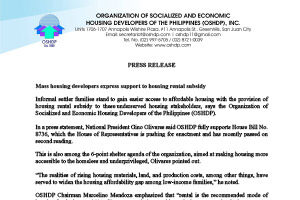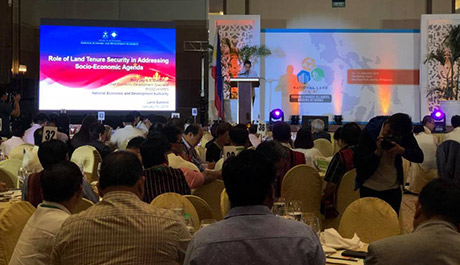Organization’s Profile & History
 What OSHDP today is the outcome of dedication of a number of real estate developers and individuals who relentlessly sought means to advance the cause of better housing delivery to many who dream of having a decent home.
What OSHDP today is the outcome of dedication of a number of real estate developers and individuals who relentlessly sought means to advance the cause of better housing delivery to many who dream of having a decent home.
Faced with ever changing policy in housing finance, socialized housing developers assisted by the National Home Mortgage Finance Corporation’s (NHMFC) development financing saw it fit to have a voice in the housing sector. They organized in August 1995 an association whose incorporators include active practitioners in the field who at this point are faced with ambiguity of continued funding for the state’s central housing finance program known then as the Unified Home Lending Program (UHLP) of NHMFC. Founding president is Orlando Bongat of Durawood Lumber and Construction who now is among the organization’s Board advisers.
The core group initially held meetings periodically particularly as they are prodded by the impending impact of new rulings on housing development and finance. OSHDP, practically struggling in existence from the group’s contributions and advances, held its first formal planning exercise in 1997. Facilitated by Arch. Amado Viray, the activity had the organizers establish its mission and vision statement, enlisting its objectives and prime thrust in pursuing its aspiration. He was installed as the Secretary General of OSHDP also during this period and continued to assume the post until 2009.
In her term as OSHDP president in 1997, Mrs. Zenaida de Asis of AL Realty & Development Corporation, Lucena was confronted by the adverse effects of the collapse of then Unified Home Lending Program (UHLP) of NHMFC. UHLP was the primary window for home lending particularly of low-end homebuyers. The eventual transfer of the financing program to Pag-IBIG had taken toll as the institution huddled means to minimize risks involved in what then under UHLP was formula lending. The worse happened as economic crunch hits Asia on the same year.
To stay afloat, most in the group downsized operations and sought means to liquefy its staling housing inventory. Some members were not able to hold on and tried to diversify while others had to simply close shop. The sorry state of the industry has driven OSHDP officers to meet more often to find ways in unlocking funds for home financing. It collaborated with other private housing associations in its goal to establish a fresh window for homebuyer financing. It is during also this time that the association actively participated in crafting the guidelines for the proposed Multi-window Lending Program (MWLP), which in the end did not take off as the system failed to lure back GSIS and SSS to participate in direct home buyer financing after the UHLP debacle.
With some members of OSHDP who were assisted by NHMFC developmental financing program not able to repay their obligation, the association sought means for which to settle loans with the institution. Among the highlights of OSHDP accomplishment, it is in this pursuit that the thrust of assisting its members cannot be overemphasized. NHMFC approved in 1999 the dacion en pago mode of settling outstanding development loans of developer members that provided them relief from the tedious and costly process of foreclosure.
1999 under the leadership of Giovanni Olivares of Malate Construction and Development Corporation had seen OSHDP getting the recognition in the industry. It became the private sector representative in the Housing and Urban Development Coordinating Council (HUDCC), helped draft guidelines for the Pasig Rehabilitation’s Housing and Resettlement program and importantly, launched the Philippine Medium-Term Development Plan for Housing.
Mr. Wilfredo Tan of Hausland Assets and Realty (now Hausland Development Corporation) had taken turns with Mr. Olivares assuming presidency of OSHDP. In the succeeding years, the association’s efforts started paying off. It takes the lead in making an in depth on price ceiling adjustment for socialized housing package as provided for in the law. This effort bears significantly on the industry as it sets the benchmark for the incentives for socialized housing development and as reference to investments in mass housing development on larger scale. The group’s pursuit had proven worthy with the favorable action of the government on the proposed price adjustments OSHDP had sought.
In 2000 OSHDP became the first chairman of the Private Sector Consultative Council for Shelter. To streamline and consolidate positions of the various private housing associations, the Council constantly dialogued with HUDCC, shelter agencies and institutions that have stake in housing. The organization also actively participated in legislations for and hearings on proposed bills that involve mass housing development.
Among the notable gains of the association is its partnership with Pag-IBIG Fund in assessing the institution’s home lending program and proposing measures that would make it more accessible to its members. OSHDP facilitated the cancellation of credit insurance that proved costly to developers as it hardly served the purpose and persuaded Pag-IBIG to lower loan interest rate.
When the Securities and Exchange Commission announced the adoption of International Financial Reporting Interpretation Committee’s IFRIC Interpretation 15 pertaining to construction and real estate sector’s manner of recognizing sale and income, Mr. Bansan Choa, accountant that he is and 2008 OSHDP president, gathered major stakeholders in the industry to seek relief from the measure and more time to study the accounting method requirement. If implemented, practitioners are likely to report minimal income or even loss in the early years of operation per project as sale of a housing unit is figured only with full payment of the buyer or client and the full transfer of risk to him. The joint petition of major associations that included OSHDP, SHDA and NREA eventually obtained favorable action from SEC.
Also under the term of Mr. Choa, the revised implementing rules and regulations of BP 220 was adopted and issued after a year of nationwide consultation together with officials from the HUDCC, HLURB, DILG and attached offices and agencies.
Ms. Linda Tan, the president of the association in 2008 to 2010, had acted as OSHDP’s treasurer since its official formation. The goal of establishing OSHDP chapters was realized in her resolve to expand the outreach of the group. Under her stewardship, the following chapters were born: Davao, Bicol, Central Luzon, Cebu, and Cagayan De Oro. The first OSHDP convention held in Davao speaks of how far it has gone in the industry.
CONTINUING THE LEGACY. – In 2010, Engr. Jefferson Bongat of Duraville and son of the founding chairman/chairman emeritus of OSHDP, Mr. Orlando Bongat, assumed the presidency of the organization. This ushered a new season for OSHDP as the second generation of developers began stepping in. Under the same vision but with a renewed thrust, OSHDP continued on with its advocacies and programs that kept its sight on the most pressing issues of the day.
In line with the change in administration, and the assumption of Vice President Jejomar C. Binay as HUDCC Chairman, OSHDP was again given the opportunity to sit as private sector representative in the HUDCC Council through its Chairman Giovanni Olivares of Malate Construction and Development Corporation.
Among the burning issues were the discussions on the regular /periodic price ceiling adjustments for socialized and low-cost housing packages; inputs for the housing sector in the Philippine Development Plan, 2011-2016; advocacies on major legislations pertaining to the housing industry. e.g. RA 7279 or the Urban Development and Housing Act; representations with concerned government agencies on establishing direct and indirect incentives for socialized housing developers.
The organization likewise initiated multi-sectoral fora and consultations, through regular business meetings, that aim to develop concrete proposals on critical shelter issues. Among the concerns threshed out were the constant updates on the changes in government policies, rules, circulars and orders including Pag-IBIG new End-User Financing Policies, new implementing rules and regulations for PD 957 and RA 7279, among others.
Other advocacies of the organization under his term was the continuing review, updating and consultations on the IRR of BP 220 and PD 957; review of the IRR of the 2009 Fire Code of the Philippines; preparation of proposed amendments to RA 9646 or the Real Estate Service Act (RESA); participate and propose inputs to the Pag-IBIG Fund’s Technical Working Group on housing finance.
OSHDP had likewise made strong representation with the Board of Investments (BOI) for retention of mass housing under the 2011 Investment Priorities Plan (IPP) and the ceiling of P3.0 million housing package for the incentive, which included BIR’s recognition housing projects already covered incentives/exemptions by BOI and expedition of issuances of Certificates Authorizing Registration, without need for a BIR Ruling for every project. It also asked the Bureau of Fire Protection for exemption of socialized housing projects from the mandatory requirement of installing fire extinguishers in all housing projects provided under the New Fire Code.
In August 2011 and 2012, OSHDP successfully held its 2nd and 3rd National Convention, in partnership with HUDCC, in Clark Freeport Philippines in Pampanga and Acacia Hotel in Alabang, Muntinlupa City respectively.
OSHDP also became a member of TOPS, The Organization of Property Stakeholders with strong coordination with the Land Registration Authority (LRA) towards streamlining procedures and guidelines for the release of titles. Also, as an expansion of its membership base, OSHDP had recently organized its 6th chapter, the Pagadian Chapter.
In 2013, Atty. Christopher Ryan T. Tan assumed leadership of the organization. His presidency laid out the medium term Executive and Legislative Agenda which included strong support for the creation of the Department of Housing and Urban Development (DHUD); a more inclusive and comprehensive national land use act; a new definition of socialized housing condominiums; and revision of the IRR of BP 220 among others.
To strengthen linkages among key shelter agencies and other government institution, Atty. Tan has spearheaded courtesy calls and meetings with these agencies and initiated discussions on collaborative efforts between the government and private sector in the delivery of decent and affordable housing as well as housing finance and subsidies.
The development of a strong partnership with existing chapters was also a main direction; thus, Atty. Tan organized and launched regional business meetings that started in Cagayan De Oro City, Davao City and Pampanga respectively. OSHDP has also re-launched its quarterly newsletter, Shelter Post, which kept the members and industry stakeholders of OSHDP up to date with the current events in housing as well as the advocacies of the organization.
The passage of the National Land Use Bill was probably the most challenging issue in the 15th Congress where OSHDP, together with affiliated organizations, rallied against the passage of a version of the said bill viewed as anti-housing. While it recognized the need for a national land use act, OSHDP called for a more inclusive, consultative and comprehensive land use law acceptable to all stakeholders.
OSHDP also lobbied for a new definition of socialized housing to include condominiums and accommodate “in-city” socialized housing projects with different price ceiling level that will ensure quality socialized housing units that is still affordable.
OSHDP also played a major part in the crafting of the National Informal Settlements Upgrading Strategies or NISUS. As the only representative of the private developers, OSHDP gave its inputs to the finalization of the strategies.
Probably the biggest achievement of his term is the approval of the socialized housing price ceiling adjustment from P400,000 to P450,000.00.
Then and now, OSHDP remains to be the leading organization of socialized housing developers in the country, advancing as it does the essential issues of the day for discourse and solutions for the benefit of the mass housing industry and relative industries.
OSHDP: 20 YEARS AND BEYOND. – For as long as there is a household needing homes, OSHDP will remain to exist.
In 2015, the Board of Directors of OSHDP resolved to extend the life of the organization to another 50 years and changed the name to the “ORGANIZATION OF SOCIALZED AND ECONOMIC HOUSING DEVELOPERS OF THE PHILIPPINES, INC. (OSHDP).” The new name reflected the nature and purposes of the members of OSHDP – being BP 220 developers. OSHDP members’ projects account for the majority of mass housing projects in the country and remained to be a strong partner of the government, particularly Pag-IBIG Fund, in the delivery of quality and affordable housing to our fellow Filipinos.
Engr. George Richard Siton took over the leadership of OSHDP for the ensuing years 2015 and 2016. His terms started strong, as the Senate and House of Representatives Committees on Housing and Urban Development had jointly embarked on the calling of the National Housing Summit to address the country’s most pressing issues on shelter. OSHDP is one of the major stakeholders contributing and steering the discussions in the development of the private sector agenda that will be brought in to the summit in February 2016.
On the issues of land use, the NLUA was again brought to the fore and OSHDP was first among private developers to bring the concerns of the private sector to the Economic Development Cluster of the Cabinet. After the presentation of the organization, a memo was to be drafted to advise the President of the position of the economic cluster on the issues surrounding the same.
OSHDP was also active in participating with the Board of Investments (BOI) and Asian Development Bank (ADB) ADB Consulting Team to promote Inclusive Business as a strategic investment of the country.
OSHDP also embarked itself on the discussions of green housing and green technology and had initiated joint efforts with the IFC/World Bank Group to discuss green building and EDGE Certification. Considering that OSHDP members has already begun with their green initiatives, the organization held business meetings to know and understand this new trend, as well as observe actual case studies on developers who adopted solar panels in their projects, such as Imperial Homes. OSHDP is also working with the Climate Change Commission in aligning its programs along the green programs of the country.
Community Transformability Project Integration was also a collaboration of the organization, working with the Ateneo de Manila University, in adopting Transformative Urban Resettlement in Metro Manila Project (TURMM) being supported by the Rockefeller Foundation of the Institute of International Education. TURMM launched its electronic copy of Transformative Community Resettlement Toolbox and helped in actualizing their Toolbox and giving the ISFs “the ability to attain at a better state without looking back”.
Land constraints were also among issue in the provision of affordable housing in Metro Manila and the causes of land constraints and the alternative solutions to these issues were among the major focuses of OSHDP. One of the highlights in the policy debates is the OSHDP’s proposal to amend BP 220 and to include in the definition of “socialized housing” the word “vertical socialized housing.”
OSHDP was also active in supporting the proposal to adjust the economic housing price ceiling from P1.25 Million to P1.7 Million.
Amid all the pressing issues that the organization is facing, OSHDP did not forget about the parochial needs of its members. Aside from business meetings, the OSHDP continues to engage its members through friendly activities that camaraderie such as the annual golf tournament and the regular release of the Shelter Post. The organization also provided a regular update to members of the current events affecting housing.
At the 2015 convention, OSHDP once again made history as the organization founded the Center for Housing and Independent Research Synergies or CHAIRS. This initiative was conceived given the importance of “Housing” in the political, social and economic life of the country. In the Philippines, this field probably is the least understood as data is limited and technical studies are insufficient while the issues are so varied and complex. It is in this backdrop that OSHDP and 8990 Holdings, Inc. co-founded and institutionalized CHAIRS as a non-stock, non-profit research organization.
CORE PRINCIPLE:
“GROWTH THROUGH DIGNIFIED, QUALITY AND AFFORDABLE HOUSING”
Rationale: This is why OSHDP exists and this is why OSHDP will remain resilient in the years ahead.
MISSION-VISSION STATEMENT:
“OSHDP shall remain to be the leading organization of socialized and economic housing developers in the country, advancing as it does the essential issues of the day for discourse and solutions for the benefit of the mass housing and relative industries”












